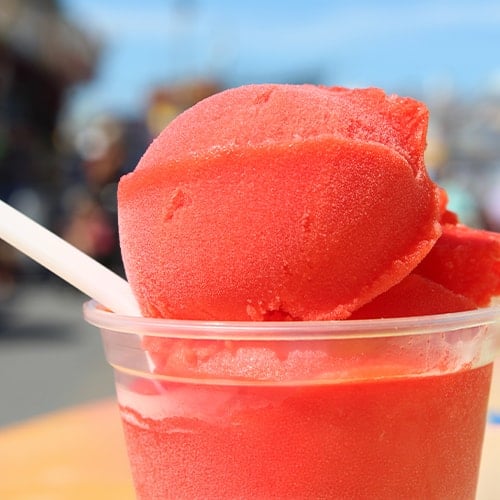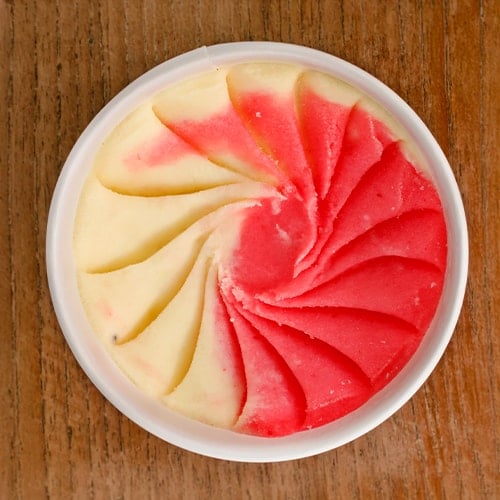What Is Italian Ice?
Last updated on Mar 6, 2025Jason KurtzItalian ice is a popular frozen dessert made from finely granulated ice, sugar, and fruit juice or flavoring syrup. It is best served during spring and summer when people want a refreshing treat. Though its roots trace back to Sicily, Italian ice as we know it today was introduced by Italian immigrants in New Jersey during the early 20th century. Today, the dessert is enjoyed across the country and is particularly popular in the Northeast United States. Its light and refreshing texture and the variety of flavors to choose from make Italian ice a favorite dessert for people of all ages.
Shop All Italian Ice and Sorbet SyrupsWhat Sets Italian Ice Apart?

Many cultures and regions have unique frozen desserts, each with distinguishing characteristics and flavors that set them apart. With so many options available, it is essential to understand what differentiates Italian ice from the rest and why it is so beloved. We'll compare Italian ice to several alternatives below so that you can make informed decisions about what options to include on your menu.
Italian Ice vs. Water Ice
Though the terms Italian ice and water ice are often used interchangeably, subtle differences make them stand out. Both desserts are made with the same ingredients but have a different texture. Italian ice has a smooth texture and fine ice consistency, while water ice typically features a chunkier, rougher texture. These differences create a unique tasting experience for each dish.
Italian Ice vs. Sorbet
Although Italian ice and sorbet are made using the same ingredients and have similar textures, their origins can be traced to different regions. As its name suggests, Italian ice originated from Italian culture. On the other hand, sorbet is a French term, and many historians attribute its origins to ancient Middle Eastern cuisine. Additionally, because of the way sorbet is churned, it typically has less air in it, which can contribute to a denser mouthfeel.
Italian Ice vs. Gelato
Italian ice and gelato are both of Italian origin but have significant differences. Gelato resembles traditional ice cream and is made with cream, milk, and sugar. For a creamier final product, some gelato also includes eggs. Gelato can also feature a variety of mix-ins such as candy, cookies, and certain spices. Conversely, Italian ice does not contain dairy or eggs. Because of this, it is a lighter and more refreshing dessert option than its counterpart.
Italian Ice vs. Shaved Ice
One notable distinction between Italian ice and shaved ice lies in their texture. Shaved ice has a coarse texture, featuring finely shaved ice crystals that create a light and fluffy consistency. In contrast, Italian ice provides a smoother and refreshing alternative, offering a more decadent mouthfeel.
Another difference lies in the way they are flavored. For shaved ice, the flavoring syrup is typically poured over the top, allowing it to seep down and infuse the ice with its taste. Italian ice flavors are incorporated into the mixture before freezing, ensuring that the entire dessert is infused.
Italian Ice vs. Sherbet
While both of these frozen desserts have a smooth consistency and feature a variety of fruit flavors, the main difference between them lies in their ingredients. Sherbet is made with dairy, typically milk or cream. This inclusion of dairy gives sherbet a creamy texture and a slightly richer flavor. On the other hand, Italian ice is made without dairy.
How to Make Italian Ice

We'll walk you through the steps to making the perfect Italian ice below. Remember that the exact measurements of ingredients you need can vary depending on the Italian ice base you use and the type of batch freezer you own.
Yields: 2 1/2 gallons Italian ice
Total Time: 15 minutes
Italian Ice Ingredients
- 2 gallons water
- 1/2 gallon Italian ice base
- 2 1/2 pounds sugar
Directions
- Pour water, Italian ice base, and sugar into large container and mix until combined.
- Pour mixture into batch freezer. Adjust settings based on specifics of unit and hit start.
- Dispense Italian ice into large tub and level off top.
- Cover tub and freeze until ready to serve.
How to Store Italian Ice

One challenge foodservice operators encounter is how to store their Italian ice effectively, as it must be kept in specific conditions to preserve its quality. For the best results, invest in commercial-grade ice cream freezers that allow you to control and monitor the temperature accurately.
The ideal storage temperature for most Italian ice varieties is between 15-20 degrees Fahrenheit, though this can vary depending on the type of base you use. If Italian ice is stored at too low a temperature, it may become solid. On the other hand, if it is stored at too high a temperature, the Italian ice will start to melt, compromising its consistency and flavor.
Italian Ice FAQ
Although Italian ice is a simple dessert, there is much to learn about it. We'll answer some of the most common questions about Italian ice below.
Is Italian Ice Healthy?
Compared to other frozen desserts, Italian ice tends to have a lower calorie count and fat content, making it a healthier alternative for health-conscious individuals looking for a sweet treat. However, it is still a dessert. Like any indulgence, Italian ice should be enjoyed in moderation to maintain a balanced diet.
Does Italian Ice Have Dairy?
Most varieties of Italian ice are dairy-free, and many are also vegan. Unlike most frozen desserts, Italian ice is made without dairy and eggs. It is important to note that some shops may offer specialty flavors that contain trace amounts of dairy products, usually stemming from mix-ins. Flavors that might contain dairy include cookie dough Italian ice and brownie bite Italian ice.
Italian ice is a beloved dessert that is enjoyed by countless people every year. It is easy and inexpensive to prepare, making it the perfect addition to your ice cream shop. Whether you're craving a classic lemon flavor or feeling adventurous with a tropical mango blend, Italian ice offers a delicious and satisfying way to cool off on a hot summer day.



